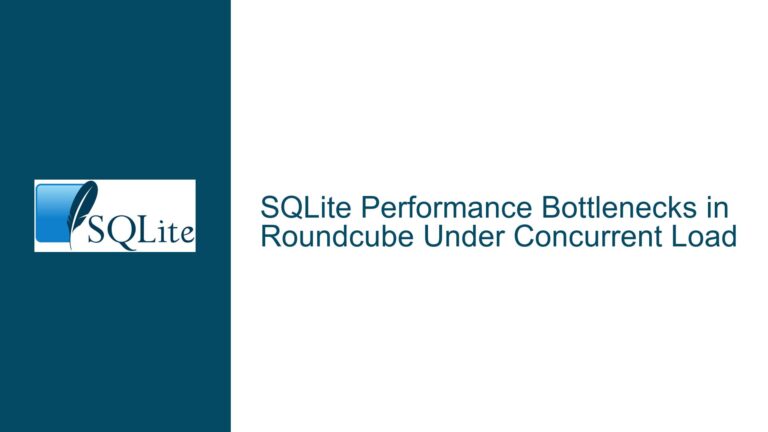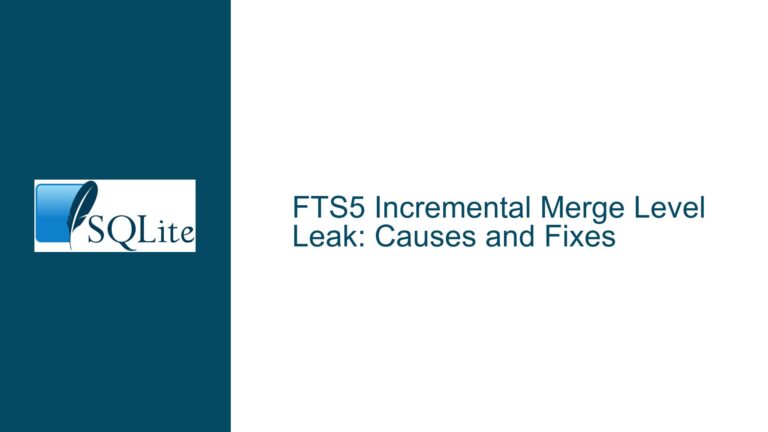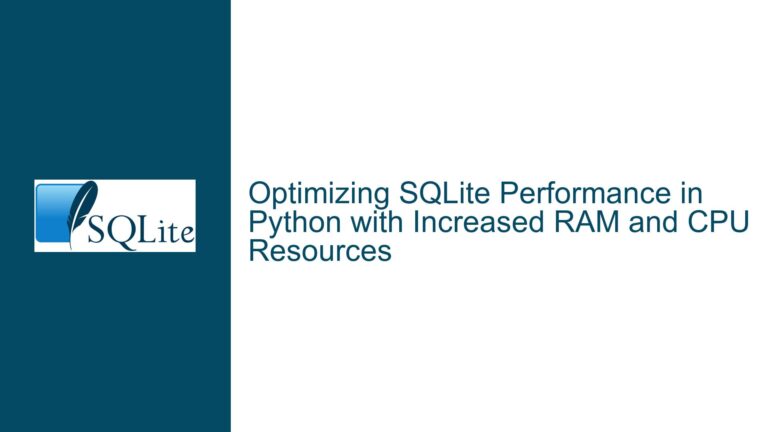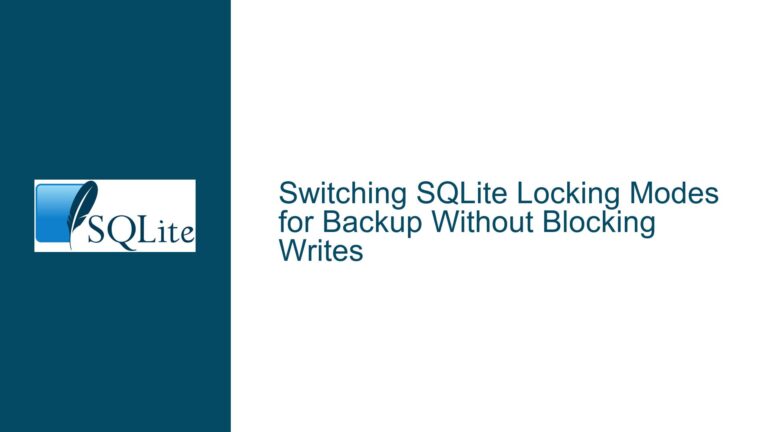and Resolving SQLite Transaction Locking and Performance Issues
Issue Overview: Implicit vs. Explicit Transactions and Their Impact on Concurrent Writes
SQLite is a lightweight, serverless database engine that is widely used in applications requiring embedded database functionality. One of its key features is its transaction management, which ensures data integrity and consistency. However, the behavior of transactions, particularly the distinction between implicit and explicit transactions, can significantly impact the performance and reliability of concurrent write operations.
In the provided discussion, the user observed a notable difference in the performance of implicit and explicit transactions when multiple threads attempt to write to the same or different tables. Specifically, the user reported a higher number of failed writes in scenarios involving implicit transactions compared to explicit transactions. This discrepancy raises important questions about how SQLite handles locking and transaction management under different conditions.
Implicit transactions are automatically started by SQLite when a statement is executed outside of an explicit transaction. They are short-lived, lasting only for the duration of the statement. Explicit transactions, on the other hand, are manually started using the BEGIN statement and must be explicitly committed or rolled back using COMMIT or ROLLBACK. The user’s observations suggest that implicit transactions are more prone to write failures under concurrent access, particularly when multiple threads are writing to the same table.
The discussion also touches on the concept of transaction upgrading, where a read transaction is upgraded to a write transaction. This can lead to deadlocks if multiple transactions attempt to upgrade simultaneously. The user’s confusion stems from the lack of clarity on why implicit and explicit transactions exhibit such different performance characteristics, especially in a multi-threaded environment.
Possible Causes: Locking Mechanisms, Transaction Duration, and Concurrency Control
The performance differences between implicit and explicit transactions can be attributed to several factors related to SQLite’s locking mechanisms, transaction duration, and concurrency control.
Locking Mechanisms: SQLite uses a locking mechanism to ensure that only one writer can access the database at a time. When a write operation is initiated, SQLite acquires a write lock on the database. If another thread attempts to write to the database while the lock is held, it will receive an SQLITE_BUSY error. Implicit transactions, being short-lived, may acquire and release locks more frequently, increasing the likelihood of contention and SQLITE_BUSY errors. Explicit transactions, which can span multiple statements, hold locks for longer periods but may reduce contention by batching writes.
Transaction Duration: The duration of a transaction plays a critical role in determining its impact on concurrent operations. Implicit transactions are inherently short-lived, as they are tied to the execution of a single statement. This brevity can lead to frequent lock acquisition and release, increasing the chances of contention. Explicit transactions, by contrast, can be held open for longer periods, allowing multiple writes to be grouped together. This reduces the frequency of lock acquisition and release, potentially lowering the likelihood of contention and SQLITE_BUSY errors.
Concurrency Control: SQLite’s concurrency control mechanisms are designed to ensure data consistency but can lead to performance bottlenecks under high contention. When multiple threads attempt to write to the same table, the likelihood of contention increases, particularly with implicit transactions. Explicit transactions, by grouping multiple writes, can reduce the number of times locks are acquired and released, thereby reducing contention.
Transaction Upgrading: Another factor contributing to the observed performance differences is transaction upgrading. In SQLite, a read transaction can be upgraded to a write transaction if a write operation is attempted. This upgrade can lead to deadlocks if multiple transactions attempt to upgrade simultaneously. Implicit transactions, which start as read transactions, are more susceptible to this issue, as they may attempt to upgrade more frequently. Explicit transactions, which can be started as write transactions using BEGIN IMMEDIATE, avoid this problem by acquiring a write lock at the start of the transaction.
Journaling Mode: The journaling mode used by SQLite can also impact transaction performance. The Write-Ahead Logging (WAL) mode, for example, allows multiple readers and a single writer to access the database simultaneously, reducing contention. However, the user’s tests were conducted with PRAGMA synchronous=1, which ensures that writes are flushed to disk before the transaction is considered complete. This setting can increase the likelihood of SQLITE_BUSY errors, particularly with implicit transactions.
Troubleshooting Steps, Solutions & Fixes: Optimizing Transaction Management for Concurrent Writes
To address the performance issues observed with implicit and explicit transactions, several strategies can be employed to optimize transaction management and reduce contention in a multi-threaded environment.
1. Use Explicit Transactions for Batch Writes: One of the most effective ways to reduce contention and improve performance is to use explicit transactions for batch writes. By grouping multiple write operations within a single transaction, the number of lock acquisitions and releases is reduced, lowering the likelihood of SQLITE_BUSY errors. This approach is particularly beneficial when multiple threads are writing to the same table.
2. Set a Busy Timeout: SQLite provides a PRAGMA busy_timeout setting that specifies the maximum amount of time a thread will wait for a lock before returning an SQLITE_BUSY error. Setting a busy timeout allows threads to wait for a short period before retrying the operation, reducing the number of failed writes. The timeout should be set to a value that is longer than the longest expected transaction duration but short enough to avoid excessive waiting.
3. Use Separate Connections for Each Thread: Each thread should use a separate database connection to ensure that transactions are isolated and do not interfere with each other. This approach allows each thread to have full control over its transaction state and reduces the likelihood of contention. Additionally, using separate connections ensures that each thread can set its own busy timeout and other pragmas without affecting other threads.
4. Avoid Transaction Upgrading: To prevent deadlocks caused by transaction upgrading, it is advisable to start transactions with BEGIN IMMEDIATE when write operations are expected. This ensures that a write lock is acquired at the start of the transaction, preventing other transactions from upgrading and causing contention. If a transaction is expected to perform only read operations, it should be started with BEGIN DEFERRED to avoid unnecessary locking.
5. Optimize Transaction Duration: Transactions should be kept as short as possible to minimize the time locks are held. This is particularly important for explicit transactions, which can span multiple statements. By reducing the duration of transactions, the likelihood of contention and SQLITE_BUSY errors is reduced. Additionally, any non-database operations, such as logging or application logic, should be performed outside of the transaction to avoid extending its duration unnecessarily.
6. Use WAL Journaling Mode: The Write-Ahead Logging (WAL) journaling mode allows multiple readers and a single writer to access the database simultaneously, reducing contention and improving performance. When using WAL mode, the PRAGMA synchronous setting can be adjusted to balance performance and durability. For example, setting PRAGMA synchronous=NORMAL can improve performance by reducing the frequency of disk flushes, while still ensuring data integrity.
7. Implement Retry Logic: In a high-concurrency environment, it is inevitable that some operations will encounter SQLITE_BUSY errors. Implementing retry logic allows the application to handle these errors gracefully by retrying the operation after a short delay. The number of retries and the delay between retries should be carefully tuned to balance performance and resource usage.
8. Monitor and Analyze Contention: To identify and address contention issues, it is important to monitor the database’s performance and analyze the causes of SQLITE_BUSY errors. Tools such as SQLite’s sqlite3_status function can be used to gather statistics on lock usage and contention. Additionally, logging and profiling can help identify long-running transactions and other performance bottlenecks.
9. Consider Application-Level Locking: In some cases, it may be necessary to implement application-level locking to coordinate access to the database. This can be achieved using mutexes or other synchronization primitives to ensure that only one thread accesses the database at a time. While this approach can reduce contention, it may also introduce performance bottlenecks and should be used judiciously.
10. Review and Optimize SQL Statements: The performance of transactions can be influenced by the efficiency of the SQL statements being executed. Reviewing and optimizing SQL statements, such as by using indexed columns and avoiding unnecessary joins, can reduce the time transactions are held open and improve overall performance. Additionally, prepared statements should be used to reduce the overhead of parsing and compiling SQL statements.
By implementing these strategies, the performance and reliability of concurrent write operations in SQLite can be significantly improved. Understanding the nuances of implicit and explicit transactions, and how they interact with SQLite’s locking mechanisms, is key to optimizing transaction management in a multi-threaded environment.






